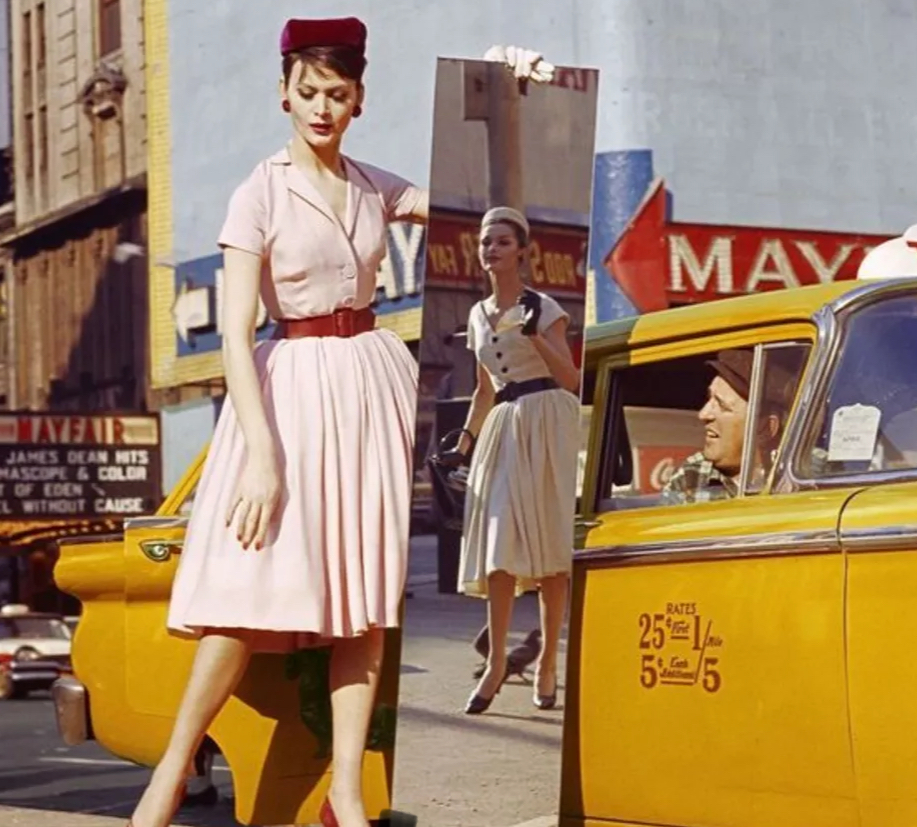William Klein’s “Anne + Isabella + Mirror + Taxi, Broadway & 46th Street, New York, 1959” is one of his most iconic works, embodying his groundbreaking approach to street photography. Known for his bold, unconventional style, Klein captured the chaotic energy of mid-20th century New York with a unique blend of grit and glamour. This photograph is an extraordinary example of his ability to distill complex urban narratives into a single frame.
Context: New York in the 1950s
The late 1950s was a time of cultural and societal transformation in New York City. The post-war economic boom brought prosperity, but also rapid urbanization and a widening gap between social classes. Times Square, where this photograph was taken, epitomized this tension—a bustling epicenter of entertainment, commerce, and stark contrasts between glamour and grit.
William Klein, returning to New York after years in Paris, sought to document the city with an unvarnished honesty that set him apart from his contemporaries. Unlike the polished imagery of commercial photography, Klein’s work celebrated imperfections, unpredictability, and the raw energy of urban life.
The Composition: Layers of Chaos and Reflection
In “Anne + Isabella + Mirror + Taxi,” Klein masterfully uses composition to create a layered narrative.
The Subjects
Anne and Isabella, two young women dressed in stylish clothing, are the focal points of the image. Their confident poses and demeanor exude a sense of youth and rebellion, characteristic of the cultural shifts of the time. The presence of a mirror, held between them, adds an intriguing layer of complexity to the scene.
The Mirror’s Role
The mirror reflects a distorted view of a taxi cab and the bustling street behind them. This element of reflection disrupts the traditional flatness of photography, drawing attention to the interplay between reality and perception. It’s a technique Klein often employed to challenge viewers, forcing them to engage more deeply with the image.
The Setting: Broadway and 46th Street
The location, with its neon lights, advertisements, and throngs of people, encapsulates the frenetic energy of New York. Klein’s wide-angle lens and high-contrast aesthetic amplify the sense of chaos, making the photograph a visceral experience rather than a static scene.
Artistic Techniques and Innovations
Klein’s approach to photography was radical for its time, breaking many of the conventions upheld by traditional photographers.
Wide-Angle Lens and Depth
The use of a wide-angle lens allowed Klein to capture a broader scene, pulling in multiple elements that create a sense of depth and motion. In this photograph, the wide angle not only frames Anne and Isabella but also incorporates the surrounding street life, making the city itself a character in the image.
High-Contrast and Grainy Aesthetic
Klein’s preference for high-contrast, grainy textures gives the photograph a gritty, almost cinematic quality. This aesthetic choice heightens the energy and immediacy of the scene, immersing viewers in the vibrancy of Times Square.
Dynamic Framing
The slightly tilted framing adds an element of instability, reflecting the chaos of urban life. Klein’s deliberate choice to avoid symmetry or perfection gives the image an unfiltered, authentic feel.
Themes and Interpretation
Urban Life and Identity
At its core, “Anne + Isabella + Mirror + Taxi” is a celebration of individuality and urban identity. The juxtaposition of the stylish young women against the chaotic backdrop of Times Square speaks to the tension between personal expression and the overwhelming forces of the city.
Youth and Rebellion
Although the self-assured poses of Anne and Isabella capture the spirit of rebellion that defined the younger generation in the 1950s, their confidence and charisma suggest a break from traditional expectations as aligning with the rise of countercultural movements.
Reality vs. Perception
The mirror serves as a metaphor for the duality of reality and perception. By incorporating reflections, Klein blurs the lines between the physical and the abstract, inviting viewers to question what they see and consider alternative perspectives.
Legacy and Influence
William Klein’s work, including “Anne + Isabella + Mirror + Taxi,” has had a profound impression on the world of photography and beyond. His style paved the way for a more experimental and personal approach to photojournalism and street photography.
Breaking Boundaries
Klein rejected the polished, sanitized aesthetic of traditional photography, choosing instead to embrace chaos, imperfection, and spontaneity. This approach influenced countless photographers, including Diane Arbus, Bruce Davidson, and Garry Winogrand.
Blurring Genres
Klein’s work also blurred the lines between art and documentary photography. By infusing his images with narrative depth and visual artistry, he demonstrated that photography could be both a record of reality and a form of creative expression.
Cultural Reflection
“Anne + Isabella + Mirror + Taxi” remains a timeless reflection of New York’s dynamic culture. Its themes of identity, rebellion, and urban chaos continue to resonate, making it relevant to audiences across generations.
Final Thoughts
“Anne + Isabella + Mirror + Taxi, Broadway & 46th Street, New York, 1959” is more than just a photograph—it’s a masterful exploration of urban life, individuality, and perception. Through his innovative techniques and bold vision, William Klein created an image that captures the essence of 1950s New York while pushing the boundaries of photography as an art form.
No comments yet.








